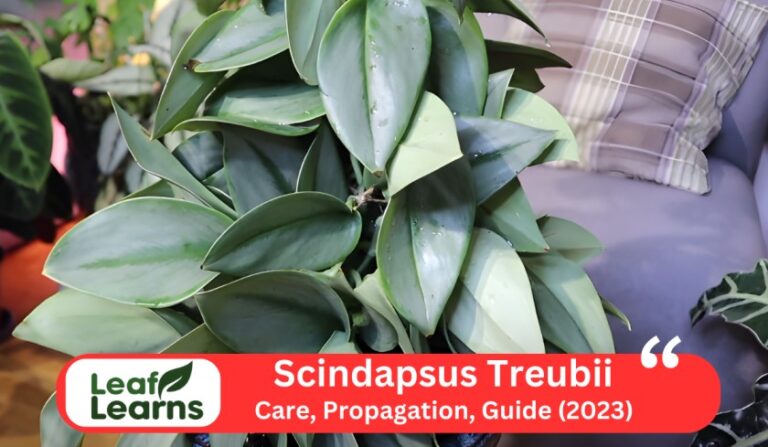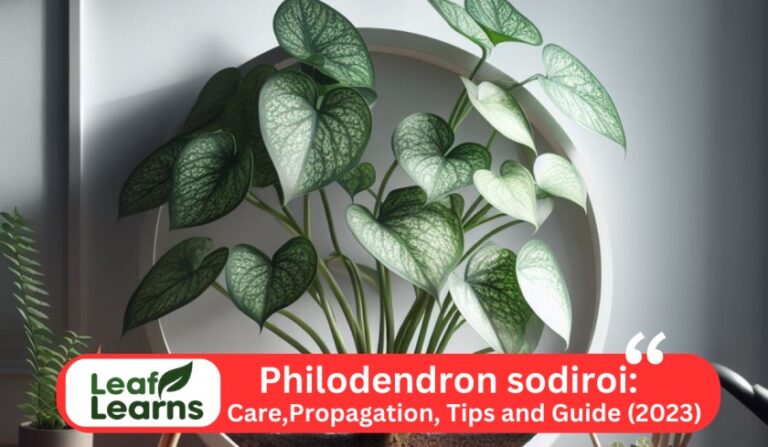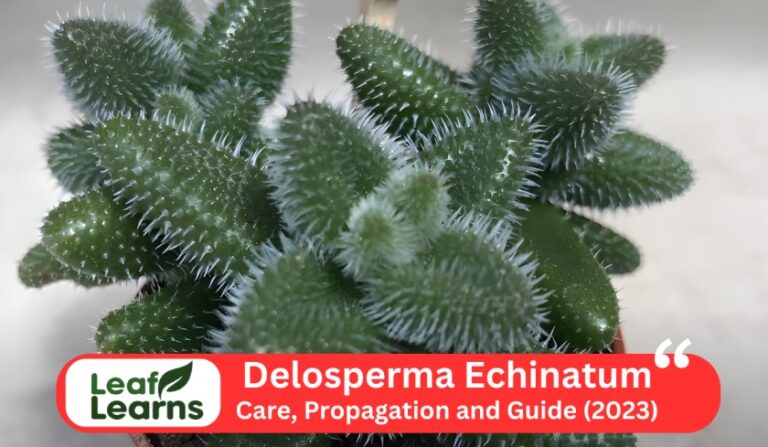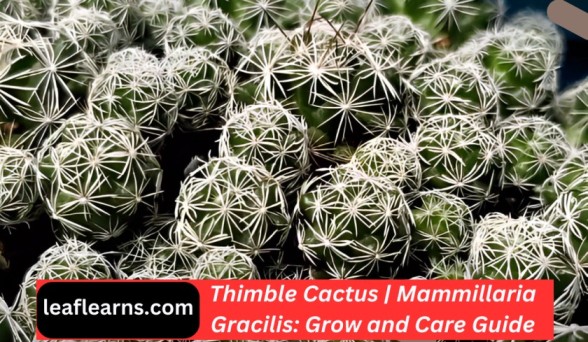Ficus Elastica or Rubber Plant Care, Grow, Tips Guide (2023)
The Rubber Plant scientifically called as Ficus Elastica. It is a member of the Moraceae family. This plant can originate from Southeast Asia and India. This rubber evergreen indoor plant can reach heights of up to 10-40 feet (3-12 meters), making it a striking addition to any indoor space.

This plant leaves come in many captivating shades having the range from dark green to deep maroon. This ficus elastica can show stunning variegation in yellow, cream, pink, or white. Maintain a temperature range of 65-75°F (18-24°C) and moderate to high humidity for this floral wonder to thrive.
To keep your Rubber Plant healthy, trim any leggy growth and prune dead leaves as needed. It thrives in bright, indirect sunlight and requires a well-draining potting mix for optimal soil health.
When watering, allow the soil to dry slightly between waterings. You can propagate this lovely plant through stem cuttings or air layering. While the Rubber Plant produces green flowers, be sure to watch out for common pests like mealybugs, scale, and spider mites to keep it in top form.
| Common name | Rubber Plant |
| Scientific Name | Ficus-Elastica |
| Family | Moraceae |
| Distribution | Southeast Asia, India |
| Plant type | Evergreen indoor plant |
| Size | Up to 10-40 feet (3-12 m) |
| Leaf Colour | Dark green, deep maroon or marked with yellow, cream, pink or white |
| Leaf size | 10–35 cm (4–14 in) long and 5–15 cm (2–6 in) broad |
| Temperature | 65-75°F (18-24°C) |
| Humidity | Moderate to high |
| Pruning | Trim leggy growth and dead leaves as needed |
| Light requirement | Bright, indirect sunlight |
| Soil requirement | Well-draining potting mix |
| Watering Need | Allow soil to dry slightly |
| Propagation | Stem cuttings, air layering |
| Flower color | Green |
| Pests | Mealybugs, scale, and spider mites |
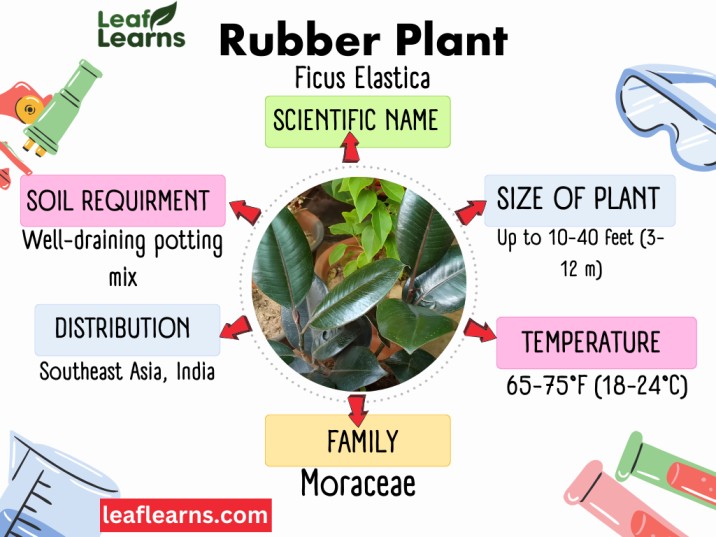
Contents
- 1 Top Care Tips
- 2 Care for Ficus Elastica or Rubber Plant
- 3 Benefits of Rubber Plant
- 4 Propagating Ficus Elastica
- 5 How to Grow Rubber Plant From Seed
- 6 Pruning
- 7 Growth Rate and Size
- 8 Repotting
- 9 Common Pests
- 10 Plant Diseases
- 11 How to Get Rubber Plant to Bloom
- 12 Problems and Solutions
- 13 Toxicity of Rubber Plant
- 14 Pets
- 15 Rubber Plant Appearance
- 16 Varieties of Rubber Plant
- 17 Suggested Uses for Rubber Plant
- 18 The Fascinating Origins and Growth of Ficus-elastica
- 19 The Benefits and Considerations of Caring for Ficus-elastica Indoors
- 20 Conclusion
- 21 FAQs
Top Care Tips
- Bright, indirect sunshine is the best place for your rubber plant. Steer clear of bright, direct sunshine since it will burn the foliage.
- Watering Moderation: Let the soil partially dry between irrigations. Striking a balance is crucial since root rot can result from overwatering.
- Maintain moderate to high levels of humidity, particularly if you reside in a dry region. Use a humidity tray or often spray the foliage.
- Pruning: To stimulate healthier, bushier growth and preserve the plant’s look, cut down on lanky growth and get rid of dead or yellowing leaves.
- Be vigilant against common pests like scale, mealybugs, and spider mites. For your Rubber Plant to remain pest-free, early diagnosis and treatment are essential.
Care for Ficus Elastica or Rubber Plant
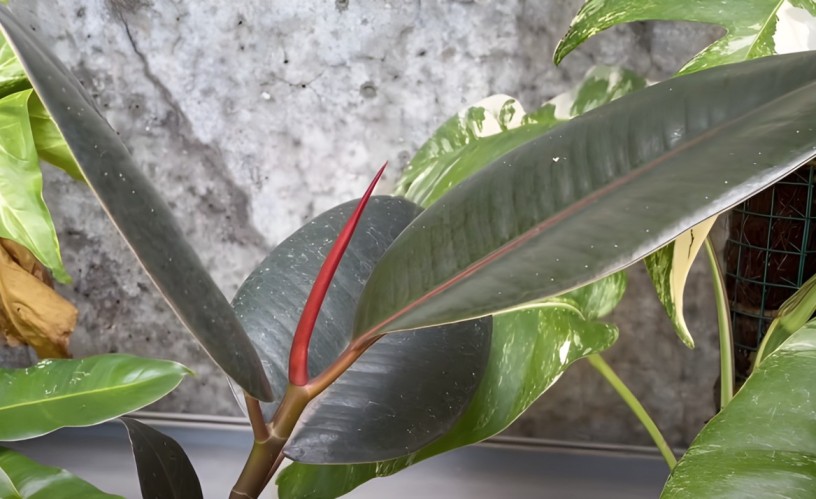
Light requirement for Rubber Plant
The rubber plant adores direct, bright sunshine. Consider it this way: It prefers the softer light you would get at a window covered with drapes.
Just keep in mind that placing it in direct sunlight might damage the foliage. Your Rubber Plant will thus grow and look its best if you provide it with the proper lighting!
Water Requirement
Like Goldilocks the Rubber Plant, wants its soil to be just right—not too moist or too dry. Try to hit that sweet spot when watering.
So that it is neither too wet nor completely dry, let the soil somewhat dry out between waterings.
By doing this, you may maintain the health and happiness of your Rubber Plant without drowning or dehydrating it. Always keep in mind that success depends on balance!
Soil Requirement
Pay attention to the soil requirements of your rubber plant when taking care of it. Use a potting mix that drains effectively. In order to avoid root rot, the soil should allow excess water to drain away.
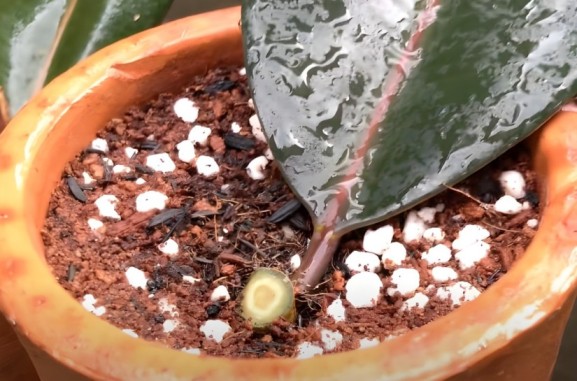
It is best to combine standard potting soil with perlite or sand. Keep in mind that healthy, happy plants need suitable soil!
Temperature Requirement
The Rubber Plant prefers a warm environment with temperatures between 65 and 75°F (18 and 24°C). Consider it to be a Goldilocks condition where it’s neither too hot nor too chilly.
This temperature range ensures the health and happiness of your rubber plant. Your Rubber Plant prefers a comfortable room just as we do! So, try to maintain it at that ideal, comfortable temperature to keep it lush and healthy.
Humidity Requirement
Rubber plants prefer a somewhat wet environment. They prefer a little moisture in the air and flourish in environments with moderate to high humidity.
They risk having crunchy leaves if the air is too dry. You may spritz them with water or set up a tray of water nearby to keep them content. Just keep in mind that they require some humidity to remain wholesome and green.
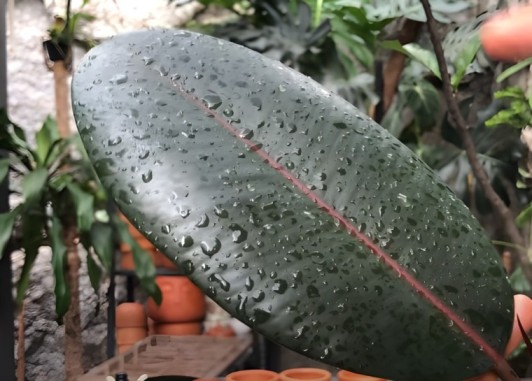
Fertilizer Requirement
For optimal growth, rubber plants, require feeding. Throughout the growth season, which is often spring and summer, they get a little meal once a month.
They can get fertilizer, a particular plant food. It is similar to vitamins to them! Your Rubber Plant will remain robust and healthy if you just follow the directions on the fertilizer packet.
Keep in mind that eating too much food might be dangerous.
Potting Requirement
It’s easy to take care of your Rubber Plant! When potting, select soil that drains properly. This prevents soggy roots by allowing the water to pass through readily.
To help excess water drain, use a pot with drainage holes. Your Rubber Plant will be happy and healthy with suitable potting soil and good drainage, which will ensure that it flourishes in its indoor environment.

Benefits of Rubber Plant
- Rubber plants make great air purifiers, eliminating formaldehyde and other pollutants from indoor air.
- Low upkeep: They are great for novices since they require little upkeep and can withstand a range of environmental factors.
- They offer a sense of elegance to any interior environment with their shiny foliage and beautiful look.
- Indoor plants like rubber plants, which have health benefits, can lower stress and improve mood.
- Natural Room Divider: They may be used to separate rooms naturally or to add seclusion to public areas.
- Longevity: Rubber Plants may thrive for many years with appropriate care, making them a durable addition to your home’s decor.
Propagating Ficus Elastica
Stem Cuttings
Take a good stem cutting that has a leaf attached and at least a few inches of stem. After letting the cut end air dry for a few hours, put it in a potting mixture that drains quickly. Till roots develop, keep the soil continually wet.
Air Layering
Make a tiny incision in the bark of a mature branch, wrap it in damp sphagnum moss, or wrap it in rooting hormone. Put plastic wrap over the spot, and eventually roots will grow. After the branch’s roots take hold, you may break it off and plant it separately.
Leaf Cuttings
It is possible to grow Rubber Plants from leaf cuttings, despite this being less often. Section a healthy leaf, then plant the pieces in a soil that drains well. New shoots should ultimately appear if the soil is continually wet
Division
You may separate a mature Rubber Plant into several smaller plants, each with its own root system, while repotting it. Make sure each split has enough stems and roots for it to grow successfully
Water Propagation
A node (where leaves and roots grow) on a stem cutting should be immersed in water when you place it in a container. After the cutting has developed roots, transplant it to soil and change the water often.
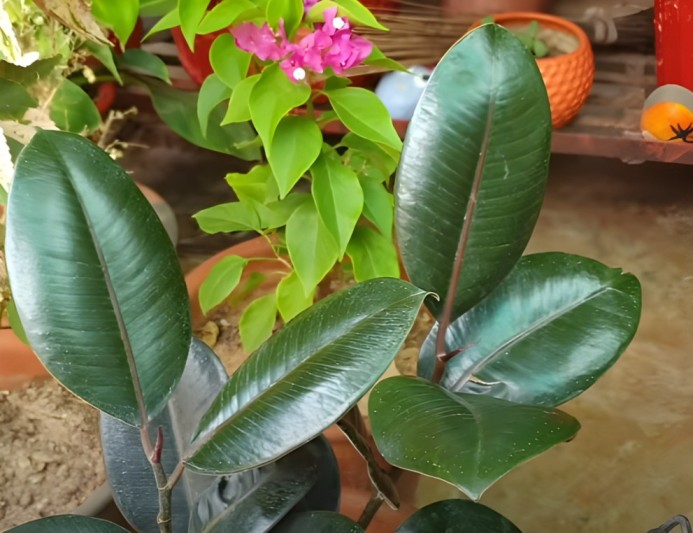
How to Grow Rubber Plant From Seed
- Gather Seeds: Take seeds from a fully grown rubber plant.
- Utilise a potting soil and perlite mixture when preparing the soil.
- Plant seeds in pots at a depth of 1/4 inch.
- Keep pots in an area that is warm and well-lit.
- Watering: Keep the soil just barely damp.
- Be patient: Sprouts may not develop for several months.
- Transplant: Once they’ve grown, move them to larger containers.
Pruning
To maintain your Rubber Plant healthy and attractive, prune it like you would a haircut. Simply cut off any long or lanky branches, and using clean scissors or pruning shears, remove any dead or yellow leaves.
This promotes healthy plant growth and keeps the plant from becoming out of hand. So, if your Rubber Plant needs it, don’t be scared to give it a small trim!
Growth Rate and Size
The Rubber Plant, develops slowly. If given enough time and room, it can eventually grow to a size of 10–40 feet (3–12 meters), starting off as a little plant.
It won’t grow overnight, but with time and the right care, it can grow into a tall and stunning interior tree. Remember that you may regulate its size by cutting it if necessary to better match your location.
Repotting
Moving your Rubber Plant, to a new, larger pot, is known as repotting. When the plant becomes too large for its present container, do this every two to three years. Select a pot with bottom drainage holes that are a little bit bigger.
The plant should be carefully taken out of its old container, given new soil, and then put back in. Allow it to relax into its new habitat and give it water. Repotting promotes healthier growth and growth for your Rubber Plant.
Flowering and Foliage
More so than its blooms, the Rubber Plant, is well-known for its stunning leaves. Its leaves might be maroon or have colorful patterning and come in a variety of green tones.
They are substantial, measuring around 4 to 14 inches long and 2 to 6 inches broad. The plant does produce tiny green blooms, but they are not the plant’s major draw.
So, rather than the blooms, the luxuriant leaves are what you should focus on if you want a stunning interior plant.
Common Pests
Your rubber plant, may encounter pest issues. Aware of mealybugs, scale, and spider mites, among other microscopic insects.
They could eat the leaves of your plant, making them appear malnourished. Check your plant frequently for these pests and get rid of them if you find any. The easiest strategy to keep pests away from your Rubber Plant is to maintain it clean and healthy.
Plant Diseases
The rubber plant is susceptible to illnesses. These issues are frequently caused by inadequate ventilation or overwatering. Root rot, which occurs when roots remain damp for an extended period of time, is one typical issue.
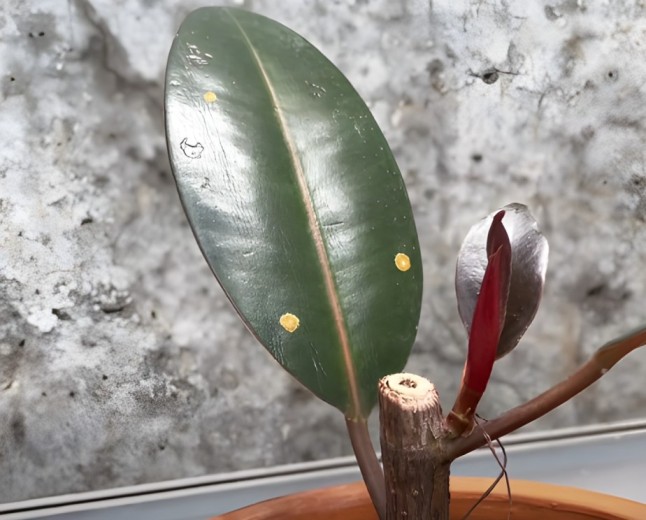
Water sparingly and make sure there is excellent drainage to avoid this. To maintain your rubber plant healthy and happy, keep an eye out for warning indications like drooping or discolored leaves and take immediate action to treat them.
How to Get Rubber Plant to Bloom
It might be challenging to get your plant to bloom because it rarely produces eye-catching blooms inside.
It is instead cultivated for its lovely foliage. But with the right care good light, moderate watering, and routine pruning you can promote growth.
You’ll see tiny, inconspicuous green flowers if it blooms. Keep in mind that the gorgeous leaves are the main focus!
Problems and Solutions
Problem: Yellowing or Drooping Leaves
Solution: Adjust watering frequency and ensure the plant receives bright, indirect sunlight.
Problem: Brown Leaf Edges or Tips
Solution: Trim the impacted sections, raise the humidity levels surrounding the plant, and keep the soil consistently moist.
Problem: Dusty or Dirty Leaves
Solution: Use a moist towel to gently clean the leaves, or rinse the plant in the shower.
Problem: Slow Growth
Solution: During the growth season, give the plant regular fertiliser and make sure the container is the right size.
Problem: Pests (e.g., mealybugs, scale)
Solution: To stop infestations from spreading, treat with neem oil or insecticidal soap and isolate the plant.
Problem: Root Rot
Solution: Increase soil drainage, cut back on how often you water, and, if required, repot the plant.
Problem: Leggy or Sparse Growth
Solution: Prune the plant to encourage bushier growth and rotate it periodically for even exposure to light.
Problem: Yellowing Lower Leaves
Solution: Natural shedding of older leaves is normal; remove them as they yellow.
Problem: Leaf Drop
Solution: Check to see whether you’re under- or overwatering, and then alter your watering to maintain a steady moisture level.
Problem: Fungus or Mildew
Solution: Enhance airflow, refrain from overwatering, and, if required, spray with an appropriate fungicide.
Problem: Too Much Direct Sunlight
Solution: To avoid leaf burning, move the plant to a location with indirect sunlight.
Toxicity of Rubber Plant
Rubber plant, may be harmful if taken by humans or animals. In that it could make their stomachs uncomfortable for them, it is comparable to spicy food.
Therefore, it is advisable to keep it away from prying eyes and mouths. Remember that while being a beautiful plant, it is not a tasty delight! If anybody chews on it, including dogs, it’s a good idea to call a doctor or veterinarian just to be safe.
Pets
Rubber plants, can be harmful to animals. The sap and leaves of this plant contain substances that, if consumed, might aggravate your animal friends’ tummies.
It’s important to either use pet-friendly plants or keep your dogs away from it. Be careful because happy pets come first!
Rubber Plant Appearance
Its leaves are thick and glossy and come in a range of hues, including maroon, deep green, and those with yellow, cream, pink, or white variegation.
The beauty and rich look of the plant are enhanced by these leaves, which can grow to be 4–14 inches long and 2–6 inches wide. Any room’s overall appearance adds a sense of elegance.
Varieties of Rubber Plant
Tineke Rubber Plant: This species of leaf’s varieties include creamy-white, pink, and vivid green hues.
Burgundy Rubber Plant: As the name suggests, the plant’s deep burgundy foliage give it a rich and lovely appearance.
Ruby Rubber Plant: This one has gorgeous and distinctive green foliage with a pinkish tint.
Robusta Rubber Plant: The Robusta is a well-known variety with substantial, big, dark green leaves.
Variegated Rubber Plant: These plants exhibit striking green and creamy-white striped patterns on their leaves.
Suggested Uses for Rubber Plant
Rubber Plant is a lovely, low-maintenance alternative for interior décor and gives a burst of greenery to your house or place of work.
These plants are excellent in removing pollutants and poisons from the air in your house while also promoting wellness.
Natural Screens or Dividers: By skillfully positioning them, you may create natural screens or dividers that offer privacy in public areas.
Aesthetic Value: Rubber plants provide beauty to any area with their gorgeous leaves, bringing life to the surroundings.
Positive Energy: According to many, indoor plants like Ficus-elastica may lower stress levels and improve self-esteem.
The Fascinating Origins and Growth of Ficus-elastica
Rubber plant is a popular indoor houseplant prized for its lush, deep green foliage and air-purifying qualities. This tropical plant, with its scientific name Ficus-elastica, originates from the rainforests of Southeast Asia, where it thrives in humid and warm natural habitats.
It can mature into a strikingly tall tree, reaching heights of up to 100 feet in its native environment.
However, when grown as a houseplant, its growth rate is considerably slower, and it typically stays at a more manageable height, making it a perfect addition to indoor spaces. One distinctive feature of Ficus-elastica is its small, glossy leaves that contribute to its aesthetic appeal and air-cleaning capabilities.
The Benefits and Considerations of Caring for Ficus-elastica Indoors
While Rubber Plant doesn’t grow to its maximum height when cultivated indoors, it still offers numerous benefits. Its economic importance lies in its ability to act as an effective air purifier, removing toxins and pollutants from the indoor environment.
The plant’s oxygen production makes it a valuable addition to any room, contributing to improved air quality. This plant low maintenance requirements, including infrequent watering and moderate light, make it a favorite among plant enthusiasts.
Additionally, its variegated cultivars, like Ficus-elastica Tineke and Ficus-elastica Ruby, add a touch of elegance to interior decor. However, it’s important to note that Rubber Plant can be toxic to pets, so it’s essential to keep it out of reach of cats and dogs to ensure their safety.
Conclusion
In conclusion, with a few key suggestions, caring for your Rubber Plant is pretty straightforward. Give it bright but indirect sunshine to keep it happy, and water it sparingly to prevent over watering.
To promote healthy development and to keep pests at bay, keep the area wet and trim it frequently. The Rubber Plant is a great option for indoor décor since it enhances air quality and gives the room a touch of natural charm.
Keep in mind that it can be poisonous to both people and animals if consumed. Your Rubber Plant will flourish and improve the atmosphere in your home with the right care.
FAQs
What is the recommended light condition for a Rubber Plant (Ficus elastica)?
Place the Rubber Plant in bright, indirect sunlight, avoiding harsh, direct sunlight.
Why is it crucial to allow the soil to dry slightly between waterings for Ficus elastica?
Maintaining a balance in irrigation is crucial since overwatering can cause root rot.
How can you maintain the right humidity levels for Ficus elastica?
By utilizing a humidity tray or often spraying the leaves, you can keep humidity levels between moderate and high.
What is the purpose of pruning Ficus elastica?
Pruning is done to remove dead or yellowing leaves and to cut back lanky growth in order to promote healthy development and preserve the plant’s look.
Why is early detection and treatment of pests important for a Rubber Plant (Ficus elastica)?
To stop common pests like mealybugs, scale, and spider mites from invading and injuring the plant, early discovery and treatment are essential.
What temperature range does Ficus elastica prefer for optimal growth?
Rubber Plant thrives at temperatures between 65 and 75°F (18-24°C).
What kind of soil is recommended for Ficus elastica, and why is it important?
To avoid root rot and encourage a healthy plant, a well-draining potting mix with excellent ventilation is advised.
How often should you fertilize a Rubber Plant (Ficus elastica) during its growing season?
Every month throughout the growth season, which is usually in the spring and summer, fertilize the plant with a particular plant meal called fertilizer.


